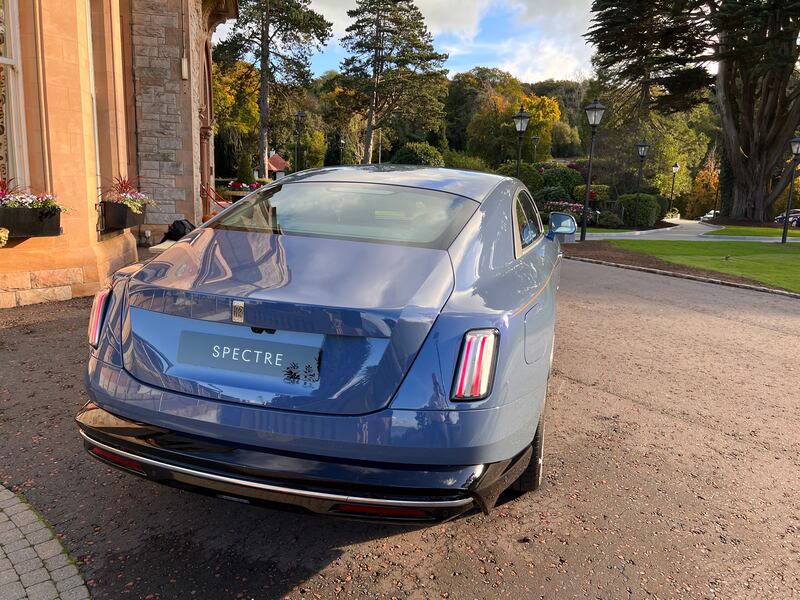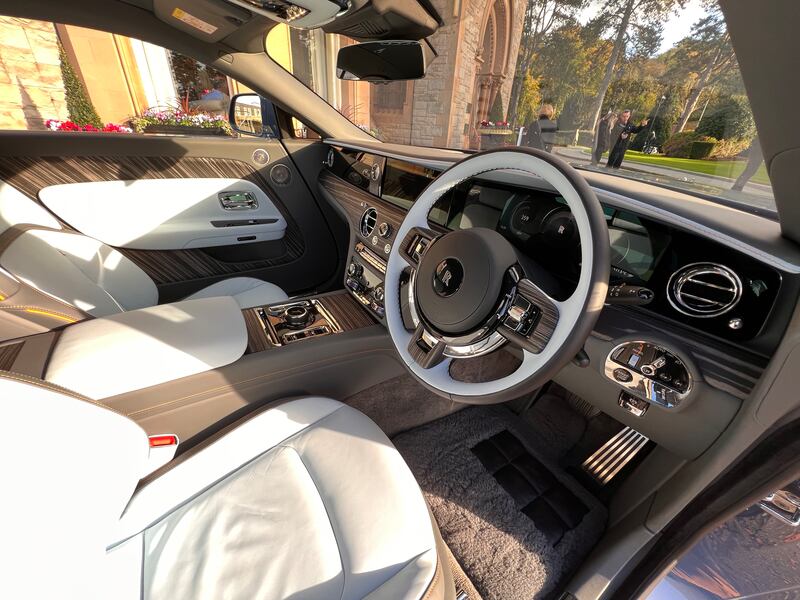Rolls-Royce is not a company that needlessly changes things. In fact, in its entire history, Rolls-Royce cars (sorry; motor cars; always motor cars) have only ever been powered by a handful of engines. That lineage started with the straight-six that powered the epochal Silver Ghost of 1909, evolved through the pre-war era, with some diversions into V12 production for the 1936 Phantom III, and a solitary inline-eight for the 1950 Phantom IV.
Since 1959 there have only been three Rolls-Royce engines. The 6.2, layer 6.75-litre V8 engine; a 5.4-litre BMW V12 engine introduced with the Silver Seraph saloon in 1998, and finally the silky-smooth 5.75-litre V12, related to BMW’s own V12 engine but assuredly a Rolls-Royce-only product, introduced with the Phantom VII in 2003.
Here comes the end of all that. This is the Spectre. It’s a sleek (it has a drag coefficient of just 0.25Cd thanks in part to a lower, wider, still-patrician grille and a ‘silver lady’ who stoops ever so slightly) four-seat coupe with 584hp and 900Nm of torque. It is also entirely electric. By 2030, Rolls-Royce — a company and a brand utterly built upon and gilded by the excellence of both its car and aircraft engines — won’t make a combustion-powered car again. It will be an entirely electric brand.
Rolls-Royce says that this is actually a natural progression, a fulfilment of the promise made by company co-founder Charles Rolls in 1901 when he said, in a magazine article, that electric power — silent, smooth, smokeless — would be ideal for a Rolls-Royce car, if only the infrastructure could be made to keep one going.
122 years later, and 118 years since Rolls and partner, Henry Royce, made an experimental V8 engine that was designed to be so smooth as to compete with electric motors, here we are. An electric Rolls-Royce car is now on sale.
Dr Philip Harnett — now Rolls-Royce’s Head Of Future Product, but formerly of the BMW-Williams F1 team, and then BMW itself, and a Dublin native — notes as he walks The Irish Times around the outside of the Spectre test car: “Since I left Dublin in 1996, this is the first time I’ve ever done anything, professionally, at home.”
Harnett’s task is to sum up the Spectre in a handful of words. No easy task. “The goal was to make a Rolls-Royce first, to make the perfect super-coupe. To make it electric was the second task.” Harnett’s words echo those of just-departed former Rolls-Royce boss Torsten Muller-Otvos, who earlier this year told The Irish Times: “Our clients live in the world’s big cities, and they use our products to commute into and out of those cities. So, for us, going electric is not all about the ecological side, that was not the intention. It was to keep the Rolls-Royce brand relevant both for our existing clients and for a whole new breed of client whom we simply haven’t seen before.”

For all that the propulsion was a secondary consideration, it had to be done right. Rolls-Royce does not sell many cars each year — just over 6,000 in 2022 — and it sells them to a tight-knit community of highly successful, wealthy, demanding individuals. Muck this up, and all that successful, wealthy, demanding cash is going to shop elsewhere.
While it’s harder to get as excited about the specification of an electric powertrain as compared to the company’s remarkable 6.75-litre V12 engine (as true a work of the engineer’s art as ever existed), the Spectre’s spec is impressive. It’s as powerful and torquey as it needs to be, with Rolls-Royce showing its habitual reticence to indulge in needless horsepower-chasing. It is, as ever, adequate sir or madam. There’s even a slightly embarrassed shuffling of feet when discussing the 0-100km/h time — 4.7secs — as if such things are all a bit nouveau riche and not quite what we do here, old thing.
The Spectre’s massive 1.5m-long door opens backwards on its rear-mounted hinges to reveal a cabin that’s as sumptuously luxurious as you’d expect, but far less showy than it could be. Our test car’s cabin colours are muted, as is the vast acreage of naturally-finished wood trim. You could easily dip deeply into the depths of vulgarity with your colour and trim choices, and many well, but the overriding impression is one of subtlety.

Yes, there are screens both for the instruments and the infotainment, but they are tucked away and most definitely not the stars of the show. That role falls to other things — the pencil-thin gear selector; the “starlight” roof lining that recreates the sky at night over Rolls’s Goodwood factory; the chunky, simple heating and ventilation controls that feel good to use, and which are far less distracting when driving than faffing around with a touchscreen.
There’s excellent space in the back — this is a full four-seater, even if those four are tall adults — but the boot measures a mere 370 litres. One will have to have one’s luggage sent ahead.
The massive door motors silently shut, and I tug at that wonderfully tactile gear selector. Most electric cars try to impress you by shunting all of their available torque through the wheels at the merest breath of pressure on the accelerator. Not the Spectre — it has been calibrated to pull away with smooth decorum, and that’s what we do. There’s no question that you can feel the potential performance lying beneath the millpond surface, but to rush is not Rolls-Royce way.
There is a major elephant lurking in an elegant corner of the Spectre’s drawing room, however. Weight. Unladen, this car —a two-door coupe remember — weighs 2,870kg. That’s more than a Land Rover Defender, and the battery — a vast 102kWh unit offering a one-charge range of 520km — is the main culprit, accounting for 700kg all by itself.
How, then, will a car that weighs three tonnes with me at the wheel comport itself in corners? With unexpected grace, is the answer. The Spectre’s steering is super-light and offers not much in the way of traditional feel or feedback. Yet it still manages to make this leviathan shrink around you to the seeming dimensions of a hot hatch.

The Spectre can be pinpoint placed through any given series of corners, and such is the brilliance of its suspension (related to that of the R-R Ghost saloon, but without the top-link as the Spectre’s structure is so much stiffer) that it can both waft, glide, and zoom at the same time. Performance is as effortless as you’d expect of a four-wheel drive car with 900Nm of torque, and the braking — with a one-pedal mode — is expertly judged. Usually, it’s under braking that you most notice the excess weight of any car, especially an electric one, but Rolls-Royce has clearly consulted the Houdini family as it’s incredibly well hidden here.
I’d even go so far as to describe it as fun. It’s not furious, not in the manner of a similarly priced Ferrari, but it’s fast, fluid, engaging, and utterly enjoyable. You can slip along in total silence (even the famed dashboard clock has had its ticking snuffed) or flip a switch to engage the artificial sound, composed by the famed Hans Zimmer, which is a mixture of V12 growl, sci-fi whooshing, and the “braaaaaaaapppppp” noise that Zimmer so memorably employed on the soundtrack to Inception. It’s entertaining if nothing else.
Okay, a little perspective. This is a car that ais going to cost, at a bare minimum, €500,000 to import here. Compared to some house prices, that’s a bit of a bargain and the Spectre most assuredly has a cabin into which you could happily move, but even so, it’s a staggeringly expensive thing. It actually manages to justify that price, though, by being so incredibly well-engineered. Something this heavy and this luxurious shouldn’t be able to move so effortlessly, but the Spectre somehow does. If that’s not enough, a visit to Rolls’ factory in Goodwood, on the southeast coast of England, should convince you. The actual care, attention, and love (not an exaggeration) that the Rolls-Royce workforce lavishes on these cars is truly something to behold. It puts an entirely different spin on the notions of value.
As an electric vehicle it’s pretty inefficient — 530km, even if it is a realistic figure, from 102kWh is pretty bad going, although it can recharge at up to 195kW (and from Tesla Superchargers too, thanks to a deal struck by Rolls-Royce). Given its sheer expense and overt lavishness, given its position as the company car of the sickeningly wealthy, it ought to be something to be shunned by the rest of us.
But it’s not. Because it’s brilliant. Charles Rolls was right. He was just a century too early.




